Before and After: A Multiscale Remote Sensing Assessment of the Sinop Dam, Mato Grosso, Brazil
Abstract
:1. Introduction
2. Materials and Methods
2.1. Study Area
2.2. Aquatic Biodiversity
2.3. Overview of Data and Analysis
2.4. Satellite Imagery
2.5. UAS Photograph Acquisition
2.6. Analysis
2.6.1. Satellite Image Classification
2.6.2. Structure from Motion Multi-View Stereo Photogrammetry (SfM-MVS)
2.6.3. SfM-MVS Products
2.7. Spaceborne LiDAR, Terrestrial Carbon Biomass
2.8. Atmospheric Methane Concentration
2.9. Visualization
3. Results
3.1. Land Cover Composition Prior to Flooding
3.2. Flooding of Small Stream Tributaries
3.3. UAS Case Study Areas and SfM-MVS Products
3.4. Data Visualization
4. Discussion
- planning for an appropriate GSD (e.g., 1–3 cm is generally sufficient for most fine scale applications),
- understanding the relationship between focal length, sensor size and flight altitude on the expected GSD,
- understanding the importance of photograph quality and target type on the outcome of the SfM workflow (e.g., the white water rapids at Corredeira do Suplício cannot be reconstructed),
- utilizing a flight planning application and flight controller software to ensure proper front and side overlap between photographs
- understanding the impact of file type and compression of the photographs on the SfM products
5. Conclusions
Supplementary Materials
Author Contributions
Funding
Data Availability Statement
Acknowledgments
Conflicts of Interest
References
- Rose, R.A.; Byler, D.; Eastman, J.R.; Fleishman, E.; Geller, G.; Goetz, S.; Guild, L.; Hamilton, H.; Hansen, M.; Headley, R.; et al. Ten ways remote sensing can contribute to conservation. Conserv. Biol. 2015, 29, 350–359. [Google Scholar] [CrossRef] [PubMed] [Green Version]
- Arvor, D.; Dubreuil, V.; Simoes, M.; Begue, A. Mapping and spatial analysis of the soybean agricultural frontier in Mato Grosso, Brazil, using remote sensing data. Geojournal 2013, 78, 833–850. [Google Scholar] [CrossRef] [Green Version]
- Sano, E.E.; Rodrigues, A.A.; Martins, E.S.; Bettiol, G.M.; Bustamante, M.M.C.; Bezerra, A.S.; Couto, A.F., Jr.; Vasconcelos, V.; Schuler, J.; Bolfe, E.L. Cerrado ecoregions: A spatial framework to assess and prioritize Brazilian savanna environmental diversity for conservation. J. Environ. Manag. 2019, 232, 818–828. [Google Scholar] [CrossRef] [PubMed]
- Diniz, C.G.; Souza, A.A.d.A.; Santos, D.C.; Dias, M.C.; Luz, N.C.d.; Moraes, D.R.V.d.; Maia, J.S.A.; Gomes, A.R.; Narvaes, I.d.S.; Valeriano, D.M.; et al. DETER-B: The New Amazon Near Real-Time Deforestation Detection System. IEEE J. Sel. Top. Appl. Earth Obs. Remote Sens. 2015, 8, 3619–3628. [Google Scholar] [CrossRef]
- Kalacska, M.; Arroyo-Mora, J.P.; Lucanus, O.; Sousa, L.; Pereira, T.; Vieira, T. Deciphering the many maps of the Xingu River Basin—An assessment of land cover classifications at multiple scales. Proc. Acad. Natl. Sci. Phila. 2020, 166, 1–55. [Google Scholar] [CrossRef]
- Bourgoin, C.; Blanc, L.; Bailly, J.S.; Cornu, G.; Berenguer, E.; Oszwald, J.; Tritsch, I.; Laurent, F.; Hasan, A.F.; Sist, P.; et al. The Potential of Multisource Remote Sensing for Mapping the Biomass of a Degraded Amazonian Forest. Forests 2018, 9, 303. [Google Scholar] [CrossRef] [Green Version]
- Bruno, D.E.; Ruban, D.A.; Tiess, G.; Pirrone, N.; Perrotta, P.; Mikhailenko, A.V.; Ermolaev, V.A.; Yashalova, N.N. Artisanal and small-scale gold mining, meandering tropical rivers, and geological heritage: Evidence from Brazil and Indonesia. Sci. Total Environ. 2020, 715, 136907. [Google Scholar] [CrossRef]
- Silva Rotta, L.H.; Alcântara, E.; Park, E.; Negri, R.G.; Lin, Y.N.; Bernardo, N.; Mendes, T.S.G.; Souza Filho, C.R. The 2019 Brumadinho tailings dam collapse: Possible cause and impacts of the worst human and environmental disaster in Brazil. Int. J. Appl. Earth Obs. Geoinf. 2020, 90, 102119. [Google Scholar] [CrossRef]
- Rudorff, N.; Rudorff, C.M.; Kampel, M.; Ortiz, G. Remote sensing monitoring of the impact of a major mining wastewater disaster on the turbidity of the Doce River plume off the eastern Brazilian coast. ISPRS J. Photogramm. Remote Sens. 2018, 145, 349–361. [Google Scholar] [CrossRef]
- Chen, G.; Powers, R.P.; de Carvalho, L.M.T.; Mora, B. Spatiotemporal patterns of tropical deforestation and forest degradation in response to the operation of the Tucuruí hydroelectric dam in the Amazon basin. Appl. Geogr. 2015, 63, 1–8. [Google Scholar] [CrossRef]
- Condé, R.; Martinez, J.-M.; Pessotto, M.; Villar, R.; Cochonneau, G.; Henry, R.; Lopes, W.; Nogueira, M. Indirect Assessment of Sedimentation in Hydropower Dams Using MODIS Remote Sensing Images. Remote Sens. 2019, 11, 314. [Google Scholar] [CrossRef] [Green Version]
- Skole, D.; Tucker, C. Tropical deforestation and habitat fragmentation in the Amazon: Satellite data from 1978 to 1988. Science 1993, 260, 1905–1910. [Google Scholar] [CrossRef] [PubMed] [Green Version]
- Silva, S.S.D.; Oliveira, I.; Morello, T.F.; Anderson, L.O.; Karlokoski, A.; Brando, P.M.; Melo, A.W.F.; Costa, J.G.D.; Souza, F.S.C.; Silva, I.S.D.; et al. Burning in southwestern Brazilian Amazonia, 2016–2019. J. Environ. Manag. 2021, 286, 112189. [Google Scholar] [CrossRef]
- Escobar, H. Brazil’s Deforestation Is Exploding—And 2020 Will Be Worse. Available online: https://www.sciencemag.org/news/2019/11/brazil-s-deforestation-exploding-and-2020-will-be-worse (accessed on 23 January 2021).
- Escobar, H. Deforestation in the Amazon is shooting up, but Brazil’s president calls the data ‘a lie’. Available online: https://www.sciencemag.org/news/2019/07/deforestation-amazon-shooting-brazil-s-president-calls-data-lie (accessed on 23 January 2021).
- Kalacska, M.; Lucanus, O.; Sousa, L.; Arroyo-Mora, J.P. High-Resolution Surface Water Classifications of the Xingu River, Brazil, Pre and Post Operationalization of the Belo Monte Hydropower Complex. Data 2020, 5, 75. [Google Scholar] [CrossRef]
- Asner, G.P. Cloud cover in Landsat observations of the Brazilian Amazon. Int. J. Remote Sens. 2001, 22, 3855–3862. [Google Scholar] [CrossRef]
- Adriano, B.; Xia, J.; Baier, G.; Yokoya, N.; Koshimura, S. Multi-Source Data Fusion Based on Ensemble Learning for Rapid Building Damage Mapping during the 2018 Sulawesi Earthquake and Tsunami in Palu, Indonesia. Remote Sens. 2019, 11, 886. [Google Scholar] [CrossRef] [Green Version]
- Niroumand-Jadidi, M.; Bovolo, F.; Bruzzone, L.; Gege, P. Physics-based Bathymetry and Water Quality Retrieval Using PlanetScope Imagery: Impacts of 2020 COVID-19 Lockdown and 2019 Extreme Flood in the Venice Lagoon. Remote Sens. 2020, 12, 2381. [Google Scholar] [CrossRef]
- Cheng, Y.; Vrieling, A.; Fava, F.; Meroni, M.; Marshall, M.; Gachoki, S. Phenology of short vegetation cycles in a Kenyan rangeland from PlanetScope and Sentinel-2. Remote Sens. Environ. 2020, 248, 112004. [Google Scholar] [CrossRef]
- Crutsinger, G.; Short, J.; Sollendberger, R. The future of UAVs in ecology: An insider perspective from the Silicon Valley drone industry. J. Unmanned Veh. Syst. 2016, 4, 161–168. [Google Scholar] [CrossRef] [Green Version]
- Ridge, J.T.; Johnston, D.W. Unoccupied Aircraft Systems (UAS) for Marine Ecosystem Restoration. Front. Mar. Sci. 2020, 7, 438. [Google Scholar] [CrossRef]
- Arroyo-Mora, J.P.; Kalacska, M.; Løke, T.; Schläpfer, D.; Coops, N.C.; Lucanus, O.; Leblanc, G. Assessing the impact of illumination on UAV pushbroom hyperspectral imagery collected under various cloud cover conditions. Remote Sens. Environ. 2021, 258, 112396. [Google Scholar] [CrossRef]
- Kalacska, M.; Lucanus, O.; Arroyo-Mora, J.P.; Laliberté, É.; Elmer, K.; Leblanc, G.; Groves, A. Accuracy of 3D Landscape Reconstruction without Ground Control Points Using Different UAS Platforms. Drones 2020, 4, 13. [Google Scholar] [CrossRef] [Green Version]
- Fonstad, M.A.; Dietrich, J.T.; Courville, B.C.; Jensen, J.L.; Carbonneau, P.E. Topographic structure from motion: A new development in photogrammetric measurement. Earth Surf. Process. Landf. 2013, 38, 421–430. [Google Scholar] [CrossRef] [Green Version]
- Micheletti, N.; Chandler, J.H.; Lane, S.N. Investigating the geomorphological potential of freely available and accessible structure-from-motion photogrammetry using a smartphone. Earth Surf. Process. Landf. 2015, 40, 473–486. [Google Scholar] [CrossRef] [Green Version]
- Carrivick, J.; Smith, M. Fluvial and aquatic applications of Structure from Motion photogrammetry and unmanned aerial vehicle/drone technology. WIREs Water 2018, 6, e1328. [Google Scholar] [CrossRef] [Green Version]
- Shintani, C.; Fonstad, M.A. Comparing remote-sensing techniques collecting bathymetric data from a gravel-bed river. Int. J. Remote Sens. 2017, 38, 2883–2902. [Google Scholar] [CrossRef]
- Kalacska, M.; Lucanus, O.; Sousa, L.; Vieira, T.; Arroyo-Mora, J.P. Freshwater Fish Habitat Complexity Mapping Using Above and Underwater Structure-From-Motion Photogrammetry. Remote Sens. 2018, 10, 1912. [Google Scholar] [CrossRef] [Green Version]
- Zarfl, C.; Lumsdon, A.E.; Berlekamp, J.; Tydecks, L.; Tockner, K. A global boom in hydropower dam construction. Aquat. Sci. 2015, 77, 161–170. [Google Scholar] [CrossRef]
- Winemiller, K.O.; McIntyre, P.B.; Castello, L.; Fluet-Chouinard, E.; Giarrizzo, T.; Nam, S.; Baird, I.G.; Darwall, W.; Lujan, N.K.; Harrison, I.; et al. Balancing hydropower and biodiversity in the Amazon, Congo, and Mekong. Science 2016, 351, 128–129. [Google Scholar] [CrossRef] [Green Version]
- Couto, T.B.A.; Olden, J.D. Global proliferation of small hydropower plants—Science and policy. Front. Ecol. Environ. 2018, 16, 91–100. [Google Scholar] [CrossRef]
- Lin, Z.; Qi, J. A New Remote Sensing Approach to Enrich Hydropower Dams’ Information and Assess Their Impact Distances: A Case Study in the Mekong River Basin. Remote Sens. 2019, 11, 3016. [Google Scholar] [CrossRef] [Green Version]
- Couto, T.B.A.; Messager, M.L.; Olden, J.D. Safeguarding migratory fish via strategic planning of future small hydropower in Brazil. Nat. Sustain. 2021, 4, 409–416. [Google Scholar] [CrossRef]
- Latrubesse, E.M.; Arima, E.Y.; Dunne, T.; Park, E.; Baker, V.R.; d’Horta, F.M.; Wight, C.; Wittmann, F.; Zuanon, J.; Baker, P.A.; et al. Damming the rivers of the Amazon basin. Nature 2017, 546, 363–369. [Google Scholar] [CrossRef] [PubMed]
- Timpe, K.; Kaplan, D. The changing hydrology of a dammed Amazon. Sci. Adv. 2017, 3. [Google Scholar] [CrossRef] [PubMed] [Green Version]
- Agostinho, A.A.; Pelicice, F.M.; Gomes, L.C. Dams and the fish fauna of the Neotropical region: Impacts and management related to diversity and fisheries. Braz. J. Biol. 2008, 68, 1119–1132. [Google Scholar] [CrossRef] [Green Version]
- Cella-Ribeiro, A.; Doria, C.R.D.; Dutka-Gianelli, J.; Alves, H.; Torrente-Vilara, G. Temporal fish community responses to two cascade run-of-river dams in the Madeira River, Amazon basin. Ecohydrology 2017, 10, e1889. [Google Scholar] [CrossRef]
- Hickford, M.J.H.; Schiel, D.R. Population sinks resulting from degraded habitats of an obligate life-history pathway. Oecologia 2011, 166, 131–140. [Google Scholar] [CrossRef]
- Rosa, C.; Secco, H.; Silva, L.G.; Lima, M.G.; Gordo, M.; Magnusson, W. Burying water and biodiversity through road constructions in Brazil. Aquat. Conserv. Mar. Freshw. Ecosyst. 2021. [Google Scholar] [CrossRef]
- Roussel, J.-M.; Covain, R.; Vigouroux, R.; Allard, L.; Treguier, A.; Papa, Y.; Le Bail, P.-Y. Fish communities critically depend on forest subsidies in small neotropical streams with high biodiversity value. Biotropica 2021. [Google Scholar] [CrossRef]
- Gunkel, G. Hydropower—A Green Energy? Tropical Reservoirs and Greenhouse Gas Emissions. CLEAN Soil Air Water 2009, 37, 726–734. [Google Scholar] [CrossRef]
- Almeida, R.M.; Shi, Q.; Gomes-Selman, J.M.; Wu, X.; Xue, Y.; Angarita, H.; Barros, N.; Forsberg, B.R.; Garcia-Villacorta, R.; Hamilton, S.K.; et al. Reducing greenhouse gas emissions of Amazon hydropower with strategic dam planning. Nat. Commun. 2019, 10, 4281. [Google Scholar] [CrossRef] [PubMed]
- Fricke, R.; Eschmeyer, W.N.; vander Laan, R. Eschmeyer’s Catalog of Fishes: Genera, Species, References. Available online: http://researcharchive.calacademy.org/research/ichthyology/catalog/fishcatmain.asp (accessed on 1 March 2021).
- Jezequel, C.; Tedesco, P.A.; Darwall, W.; Dias, M.S.; Frederico, R.G.; Hidalgo, M.; Hugueny, B.; Maldonado-Ocampo, J.; Martens, K.; Ortega, H.; et al. Freshwater fish diversity hotspots for conservation priorities in the Amazon Basin. Conserv. Biol. 2020, 34, 956–965. [Google Scholar] [CrossRef] [PubMed]
- Jezequel, C.; Tedesco, P.A.; Bigorne, R.; Maldonado-Ocampo, J.A.; Ortega, H.; Hidalgo, M.; Martens, K.; Torrente-Vilara, G.; Zuanon, J.; Acosta, A.; et al. A database of freshwater fish species of the Amazon Basin. Sci. Data 2020, 7, 1–9. [Google Scholar] [CrossRef] [Green Version]
- Fearnside, P.M. Belo Monte: Actors and arguments in the struggle over Brazil’s most controversial Amazonian dam. Die Erde 2017, 148, 14–26. [Google Scholar] [CrossRef]
- Fearnside, P.M. Brazil’s Belo Monte Dam: Lessons of an Amazonian resource struggle. Die Erde 2017, 2–3, 167–184. [Google Scholar] [CrossRef]
- Fearnside, P.M. Amazon dams and waterways: Brazil’s Tapajos Basin plans. Ambio 2015, 44, 426–439. [Google Scholar] [CrossRef] [PubMed] [Green Version]
- Arima, E.Y.; Walker, R.T.; Perz, S.; Souza, C. Explaining the fragmentation in the Brazilian Amazonian forest. J. Land Use Sci. 2016, 11, 257–277. [Google Scholar] [CrossRef]
- Fearnside, P.M.; Graca, P. BR-319: Brazil’s Manaus-Porto Velho highway and the potential impact of linking the arc of deforestation to central Amazonia. Environ. Manag. 2006, 38, 705–716. [Google Scholar] [CrossRef]
- Nepstad, D.; McGrath, D.; Stickler, C.; Alencar, A.; Azevedo, A.; Swette, B.; Bezerra, T.; DiGiano, M.; Shimada, J.; Seroa da Motta, R.; et al. Slowing Amazon deforestation through public policy and interventions in beef and soy supply chains. Science 2014, 344, 1118. [Google Scholar] [CrossRef]
- Espíndola, V.C.; Spencer, M.R.S.; Rocha, L.R.; Britto, M.R. A new species of Corydoras Lacépède (Siluriformes: Callichthyidae) from the Rio Tapajós basin and its phylogenetic implications. Papéis Avulsos Zool. (São Paulo) 2014, 54, 25–32. [Google Scholar] [CrossRef] [Green Version]
- Barthem, R.; Goulding, M. The Catfish Connection: Ecology, Migration, and Conservation of Amazon; Columbia University Press: New York, NY, USA, 1997. [Google Scholar]
- Hrbek, T.; Meliciano, N.V.; Zuanon, J.; Farias, I.P. Remarkable Geographic Structuring of Rheophilic Fishes of the Lower Araguaia River. Front. Genet. 2018, 9, 295. [Google Scholar] [CrossRef] [Green Version]
- Matos, L.S.; Santana, H.S.; Silva, J.O.S.; Carvalho, L.N. Perception of professional artesanal fishermen on the decline in the catch of matrinxa fish in the Teles Pires River, Tapajos Basin. In Padroes Ambientais Emergentes e Sustentabilidade dos Sistemas; Prandel, J.A., Ed.; Atena Editora: Ponta Grossa, PR, Brazil, 2020. [Google Scholar] [CrossRef]
- Santos, J.; Correa, S.B.; Boudreau, M.R.; Carvalho, L.N. Differential ontogenetic effects of gut passage through fish on seed germination. Acta Oecol. 2020, 108, 103628. [Google Scholar] [CrossRef]
- Planet Labs Inc. RapidEye, A.G. Satellite Imagery Product Specifications. Available online: https://www.planet.com/products/satellite-imagery/files/160625-RapidEyeImage-Product-Specifications.pdf (accessed on 23 January 2021).
- Planet Labs Inc. Our Approach. Available online: https://www.planet.com/company/approach/ (accessed on 22 April 2021).
- Planet Labs Inc. Planet Imagery Product Specification: PlanetScope & RapidEye. Available online: https://www.planet.com/products/satellite-imagery/files/1610.06_SpecSheet_Combined_Imagery_Product_Letter_ENGv1.pdf (accessed on 23 January 2021).
- Chen, G.; Weng, Q.H.; Hay, G.J.; He, Y.N. Geographic object-based image analysis (GEOBIA): Emerging trends and future opportunities. GISci. Remote Sens. 2018, 55, 159–182. [Google Scholar] [CrossRef]
- Johnson, B.A.; Ma, L. Image Segmentation and Object-Based Image Analysis for Environmental Monitoring: Recent Areas of Interest, Researchers’ Views on the Future Priorities. Remote Sens. 2020, 12, 1772. [Google Scholar] [CrossRef]
- Johansen, K.; Sallam, N.; Robson, A.; Samson, P.; Chandler, K.; Derby, L.; Eaton, A.; Jennings, J. Using GeoEye-1 Imagery for Multi-Temporal Object-Based Detection of Canegrub Damage in Sugarcane Fields in Queensland, Australia. GISci. Remote Sens. 2018, 55, 285–305. [Google Scholar] [CrossRef]
- Demarchi, L.; van de Bund, W.; Pistocchi, A. Object-Based Ensemble Learning for Pan-European Riverscape Units Mapping Based on Copernicus VHR and EU-DEM Data Fusion. Remote Sens. 2020, 12, 1222. [Google Scholar] [CrossRef] [Green Version]
- Pix4D. Initial Processing -> Calibration. Available online: https://support.pix4d.com/hc/en-us/articles/205327965-Menu-Process-Processing-Options-1-Initial-Processing-Calibration (accessed on 22 April 2021).
- Strecha, C.; Bronstein, A.; Bronstein, M.M.; Fua, P. LDAHash: Improved Matching with Smaller Descriptors. IEEE Trans. Pattern Anal. Mach. Intell. 2012, 34, 66–78. [Google Scholar] [CrossRef] [PubMed] [Green Version]
- Strecha, C.; Kung, O.; Fua, P. Automatic mapping from ultra-light UAV imagery. In Proceedings of the 2012 European Calibration and Orientation Workshop, Barcelona, Spain, 8–10 February 2012; pp. 1–4. [Google Scholar]
- Strecha, C.; von Hansen, W.; Van Gool, L.; Fua, P.; Thoennessen, U. On Benchmarking camera calibration and multi-view stereo for high resolution imagery. In Proceedings of the IEEE Conference on Computer Vision and Pattern Recognition, Anchorage, AK, USA, 23–28 June 2008. [Google Scholar]
- Shumway, C.A.; Hofmann, H.A.; Dobberfuhl, A.P. Quantifying habitat complexity in aquatic ecosystems. Freshw. Biol. 2007, 52, 1065–1076. [Google Scholar] [CrossRef]
- St. Pierre, J.I.; Kovalenko, K.E. Effect of habitat complexity attributes on species richness. Ecosphere 2014, 5, art22. [Google Scholar] [CrossRef]
- McCormick, M.I. Comparison of field methods for measuring surface topography and their associations with a tropical reef fish assemblage. Mar. Ecol. Prog. Ser. 1994, 112, 87–96. [Google Scholar] [CrossRef]
- Walbridge, S.; Slocum, N.; Pobuda, M.; Wright, D.M. Unified Geomorphological Analysis Workflows with Benthic Terrain Modeler. Geosciences 2018, 8, 94. [Google Scholar] [CrossRef] [Green Version]
- Sappington, J.; Longshore, K.; Thompson, D. Quantifying Landscape Ruggedness for Animal Habitat Analysis: A Case Study Using Bighorn Sheep in the Mojave Desert. J. Wildl. Manag. 2007, 71, 1419–1426. [Google Scholar] [CrossRef]
- Backes, A.R.; Eler, D.M.; Minghim, R.; Bruno, O.M. Characterizing 3D shapes using fractal dimension. In Progress in Pattern Recognition, Image Analysis, Computer Vision, and Applications SE-7; Bloch, I., Cesar, R., Jr., Eds.; Springer: Heidelberg, Germany, 2012; pp. 14–21. [Google Scholar]
- Reichert, J.; Backes, A.R.; Schubert, P.; Wilke, T.; Mahon, A. The power of 3D fractal dimensions for comparative shape and structural complexity analyses of irregularly shaped organisms. Methods Ecol. Evol. 2017, 8, 1650–1658. [Google Scholar] [CrossRef]
- Simard, M.; Pinto, N.; Fisher, J.B.; Baccini, A. Mapping forest canopy height globally with spaceborne lidar. J. Geophys. Res. 2011, 116. [Google Scholar] [CrossRef] [Green Version]
- Spawn, S.A.; Sullivan, C.C.; Lark, T.J.; Gibbs, H.K. Harmonized global maps of above and belowground biomass carbon density in the year 2010. Sci. Data 2020, 7, 112. [Google Scholar] [CrossRef]
- Spawn, S.A.; Gibbs, H.K. Global Aboveground and Belowground Biomass Carbon Density Maps for the Year 2010; ORNL DAAC: Oak Ridge, TN, USA, 2020.
- Lorente, A.; Borsdorff, T.; Butz, A.; Hasekamp, O.; aan de Brugh, J.; Schneider, A.; Wu, L.H.; Hase, F.; Kivi, R.; Wunch, D.; et al. Methane retrieved from TROPOMI: Improvement of the data product and validation of the first 2 years of measurements. Atmos. Meas. Tech. 2021, 14, 665–684. [Google Scholar] [CrossRef]
- Hasekamp, O.; Lorente, A.; Hu, H.; Butz, A.; aan de Brugh, J.; Landgraf, J. Algorithm Theoretical Baseline Document for Sentinel-5 Precursor Methane Retrieval. Available online: http://www.tropomi.eu/sites/default/files/files/publicSentinel-5P-TROPOMI-ATBD-Methane-retrieval.pdf (accessed on 22 April 2021).
- Buchwitz, M.; Schneising, O.; Reuter, M.; Heymann, J.; Krautwurst, S.; Bovensmann, H.; Burrows, J.P.; Boesch, H.; Parker, R.J.; Somkuti, P.; et al. Satellite-derived methane hotspot emission estimates using a fast data-driven method. Atmos. Chem. Phys. 2017, 17, 5751–5774. [Google Scholar] [CrossRef] [Green Version]
- Muñoz Sabater, J. ERA5-Land Monthly Averaged Data from 1981 to Present. Copernicus Climate Change Service (C3S) Climate Data Store (CDS). Available online: https://doi.org/10.24381/cds.68d2bb30 (accessed on 16 May 2021).
- Liberatore, M.J.; Wagner, W.P. Virtual, mixed, and augmented reality: A systematic review for immersive systems research. Virtual Real. 2021. [Google Scholar] [CrossRef]
- Yeung, A.W.K.; Tosevska, A.; Klager, E.; Eibensteiner, F.; Laxar, D.; Stoyanov, J.; Glisic, M.; Zeiner, S.; Kulnik, S.T.; Crutzen, R.; et al. Virtual and Augmented Reality Applications in Medicine: Analysis of the Scientific Literature. J. Med. Internet Res. 2021, 23, e25499. [Google Scholar] [CrossRef] [PubMed]
- Leigh, C.; Heron, G.; Wilson, E.; Gregory, T.; Clifford, S.; Holloway, J.; McBain, M.; Gonzalez, F.; McGree, J.; Brown, R.; et al. Using virtual reality and thermal imagery to improve statistical modelling of vulnerable and protected species. PLoS ONE 2019, 14, e0217809. [Google Scholar] [CrossRef] [PubMed] [Green Version]
- Billen, M.I.; Kreylos, O.; Hamann, B.; Jadamec, M.A.; Kellogg, L.H.; Staadt, O.; Sumner, D.Y. A geoscience perspective on immersive 3D gridded data visualization. Comput. Geosci. 2008, 34, 1056–1072. [Google Scholar] [CrossRef] [Green Version]
- Sinop Energia. Sinop HPP. Available online: https://www.sinopenergia.com.br/ (accessed on 22 April 2021).
- Kalacska, M.; Lucanus, O.; Sousa, L.; Arroyo-Mora, J.P. A New Multi-Temporal Forest Cover Classification for the Xingu River Basin, Brazil. Data 2019, 4, 114. [Google Scholar] [CrossRef] [Green Version]
- Athayde, S.; Mathews, M.; Bohlman, S.; Brasil, W.; Doria, C.R.C.; Dutka-Gianelli, J.; Fearnside, P.M.; Loiselle, B.; Marques, E.E.; Melis, T.S.; et al. Mapping research on hydropower and sustainability in the Brazilian Amazon: Advances, gaps in knowledge and future directions. Curr. Opin. Environ. Sustain. 2019, 37, 50–69. [Google Scholar] [CrossRef]
- Deemer, B.R.; Harrison, J.A.; Li, S.; Beaulieu, J.J.; DelSontro, T.; Barros, N.; Bezerra-Neto, J.F.; Powers, S.M.; Dos Santos, M.A.; Vonk, J.A. Greenhouse Gas Emissions from Reservoir Water Surfaces: A New Global Synthesis. Bioscience 2016, 66, 949–964. [Google Scholar] [CrossRef] [PubMed]
- Kemenes, A.; Forsberg, B.R.; Melack, J.M. CO2 emissions from a tropical hydroelectric reservoir (Balbina, Brazil). J. Geophys. Res. 2011, 116. [Google Scholar] [CrossRef] [Green Version]
- Demarty, M.; Bastien, J. GHG emissions from hydroelectric reservoirs in tropical and equatorial regions: Review of 20 years of CH4 emission measurements. Energy Policy 2011, 39, 4197–4206. [Google Scholar] [CrossRef]
- Potter, C.; Brooks-Genovese, V.; Klooster, S.; Torregrosa, A. Biomass burning emissions of reactive gases estimated from satellitedata analysis and ecosystem modeling for the Brazilian Amazon region. J. Geophys. Res. 2002, 107, 8056. [Google Scholar] [CrossRef] [Green Version]
- de Araújo, K.R.; Sawakuchi, H.O.; Bertassoli Jr, D.J.; Sawakuchi, A.O.; da Silva, K.D.; Vieira, T.B.; Ward, N.D.; Pereira, T.S. Carbon dioxide (CO2) concentrations and emission in the newly constructed Belo Monte hydropower complex in the Xingu River, Amazonia. Biogeosciences 2019, 16, 3527–3542. [Google Scholar] [CrossRef] [Green Version]
- de Faria, F.A.M.; Jaramillo, P.; Sawakuchi, H.O.; Richey, J.E.; Barros, N. Estimating greenhouse gas emissions from future Amazonian hydroelectric reservoirs. Environ. Res. Lett. 2015, 10, 124019. [Google Scholar] [CrossRef] [Green Version]
- Swanson, A.C.; Bohlman, S. Cumulative Impacts of Land Cover Change and Dams on the Land–Water Interface of the Tocantins River. Front. Environ. Sci. 2021, 9, 120. [Google Scholar] [CrossRef]
- Cabeceira, F. Relações Entre Estrutura do Habitat, Composição Taxonômica e Trófica de Peixes em Riachos da Bacia do rio Teles Pires, Amazônia. Meridional. Thesis, Universidade Federal de Mato Grosso, Cuiabá, Brazil, 2014. [Google Scholar]
- Wertheimer, R.H.; Evans, A.F. Downstream passage of steelhead kelts through hydroelectric dams on the Lower Snake and Columbia Rivers. Trans. Am. Fish. Soc. 2005, 134, 853–865. [Google Scholar] [CrossRef]
- Ohara, W.M.; Lima, F.C.T.; Salvador, G.N.; Andrade, M.C. Peixes do rio Teles Pires: Diversidade e Guia de Identificação; Gráfica e Editora Amazonas: Goiânia, Brazil, 2017; p. 408. [Google Scholar]
- Ram, H.Y.M.; Sehgal, A.; ZSI. Podostemaceae—An Evolutionary Enigma; Zoological Survey India: Calcutta, India, 2007; pp. 37–66. [Google Scholar]
- Cunliffe, A.M.; Brazier, R.E.; Anderson, K. Ultra-fine grain landscape-scale quantification of dryland vegetation structure with drone-acquired structure-from-motion photogrammetry. Remote Sens. Environ. 2016, 183, 129–143. [Google Scholar] [CrossRef] [Green Version]
- Chirayath, V.; Instrella, R. Fluid lensing and machine learning for centimeter-resolution airborne assessment of coral reefs in American Samoa. Remote Sens. Environ. 2019, 235. [Google Scholar] [CrossRef]
- Fraser, B.T.; Congalton, R.G. Issues in Unmanned Aerial Systems (UAS) data collection of complex forest environments. Remote Sens. 2018, 10, 908. [Google Scholar] [CrossRef] [Green Version]
- Joyce, K.E.; Duce, S.; Leahy, S.M.; Leon, J.; Maier, S.W. Principles and practice of acquiring drone-based image data in marine environments. Mar. Freshw. Res. 2019, 70, 952–963. [Google Scholar] [CrossRef]
- Resop, J.P.; Lehmann, L.; Hession, W.C. Drone laser scanning for modeling riverscape topography and vegetation: Comparison with traditional aerial LiDAR. Drones 2019, 3, 35. [Google Scholar] [CrossRef] [Green Version]
- Ventura, D.; Dubois, S.F.; Bonifazi, A.; Lasinio, G.J.; Seminara, M.; Gravina, M.F.; Ardizzone, G. Integration of close-range underwater photogrammetry with inspection and mesh processing software: A novel approach for quantifying ecological dynamics of temperate biogenic reefs. Remote Sens. Ecol. Conserv. 2021. [Google Scholar] [CrossRef]
- Woodget, A.S.; Austrums, R.; Maddock, I.P.; Habit, E. Drones and digital photogrammetry: From classifications to continuums for monitoring river habitat and hydromorphology. Wiley Interdiscip. Rev. Water 2017, 4. [Google Scholar] [CrossRef] [Green Version]
- Bianco, S.; Ciocca, G.; Marelli, D. Evaluating the performance of Structure from Motion pipelines. J. Imaging 2018, 4, 98. [Google Scholar] [CrossRef] [Green Version]
- Dering, G.M.; Micklethwaite, S.; Thiele, S.T.; Vollgger, S.A.; Cruden, A.R. Review of drones, photogrammetry and emerging sensor technology for the study of dykes: Best practises and future potential. J. Volcanol. Geotherm. Res. 2019, 373, 148–166. [Google Scholar] [CrossRef]
- Gomez-Gutierrez, A.; de Sanjose-Blasco, J.J.; Lozano-Parra, J.; Berenguer-Sempere, F.; de Matias-Bejarano, J. Does HDR pre-processing improve the accuracy of 3D models obtained by means of two conventional SfM-MVS software packages? The case of the Corral del Veleta rock glacier. Remote Sens. 2015, 7, 10269–10294. [Google Scholar] [CrossRef] [Green Version]
- Mikita, T.; Balkova, M.; Bajer, A.; Cibulka, M.; Patocka, Z. Comparison of different remote sensing methods for 3D modeling of small rock outcrops. Sensors 2020, 20, 1663. [Google Scholar] [CrossRef] [PubMed] [Green Version]
- Mousavi, V.; Khosravi, M.; Ahmadi, M.; Noori, N.; Naveh, A.H.; Varshosaz, M. The performance evaluation of multi-image 3D reconstruction software with different sensors. In International Conference on Sensors & Models in Remote Sensing & Photogrammetry; Arefi, H., Motagh, M., Eds.; EBSCO Industries, Inc.: East Birmingham, AL, USA, 2015; Volume 41, pp. 515–519. [Google Scholar]
- Niederheiser, R.; Mokros, M.; Lange, J.; Petschko, H.; Prasicek, G.; Elberink, S.O. Deriving 3D point clouds from terrestrial photographs comparison of different sensors and software. In XXIII ISPRS Congress; Commission, V., Halounova, L., Safar, V., Remondino, F., Hodac, J., Pavelka, K., Shortis, M., Rinaudo, F., Scaioni, M., Boehm, J., et al., Eds.; 2016; Volume 41, pp. 685–692. Available online: https://www.researchgate.net/profile/Martin-Mokros/publication/307530339_DERIVING_3D_POINT_CLOUDS_FROM_TERRESTRIAL_PHOTOGRAPHS_-_COMPARISON_OF_DIFFERENT_SENSORS_AND_SOFTWARE/links/57c95a1308aedb6d6d978bab/DERIVING-3D-POINT-CLOUDS-FROM-TERRESTRIAL-PHOTOGRAPHS-COMPARISON-OF-DIFFERENT-SENSORS-AND-SOFTWARE.pdf (accessed on 16 May 2021).
- Schoning, J.; Heidemann, G. Evaluation of multi-view 3D reconstruction software. In Computer Analysis of Images and Patterns, Caip 2015, Pt II; Azzopardi, G., Petkov, N., Eds.; Springer: New York, NY, USA, 2015; Volume 9257, pp. 450–461. [Google Scholar]
- Vlachos, M.; Berger, L.; Mathelier, R.; Agrafiotis, P.; Skarlatos, D. Software comparison for underwater archaeological photogrammetric applications. In 27th CIPA International Symposium: Documenting the Past for a Better Future; Gonzalez Aguilera, D., Remondino, F., Toschi, I., Rodriguez Gonzalvez, P., Stathopoulou, E., Eds.; Cyprus University of Technology: Limassol, Cyprus, 2019; Volume 42-2, pp. 1195–1201. [Google Scholar]
- Bos, D.; Miller, S.; Bull, E. Using virtual reality (VR) for teaching and learning in geography: Fieldwork, analytical skills, and employability. J. Geogr. High. Educ. 2021, 10, 1–10. [Google Scholar] [CrossRef]
- Kalacska, M.; Arroyo-Mora, J.P.; Lucanus, O. Comparing UAS LiDAR and Structure-from-Motion Photogrammetry for peatland mapping and virtual reality (VR) visualization. Drones 2021, 5, 36. [Google Scholar] [CrossRef]
- Fearnside, P.M. Brazil’s Sao Luiz do Tapajos Dam: The Art of Cosmetic Environmental Impact Assessments. Water Altern. Interdiscip. J. Water Politics Dev. 2015, 8, 373–396. [Google Scholar]
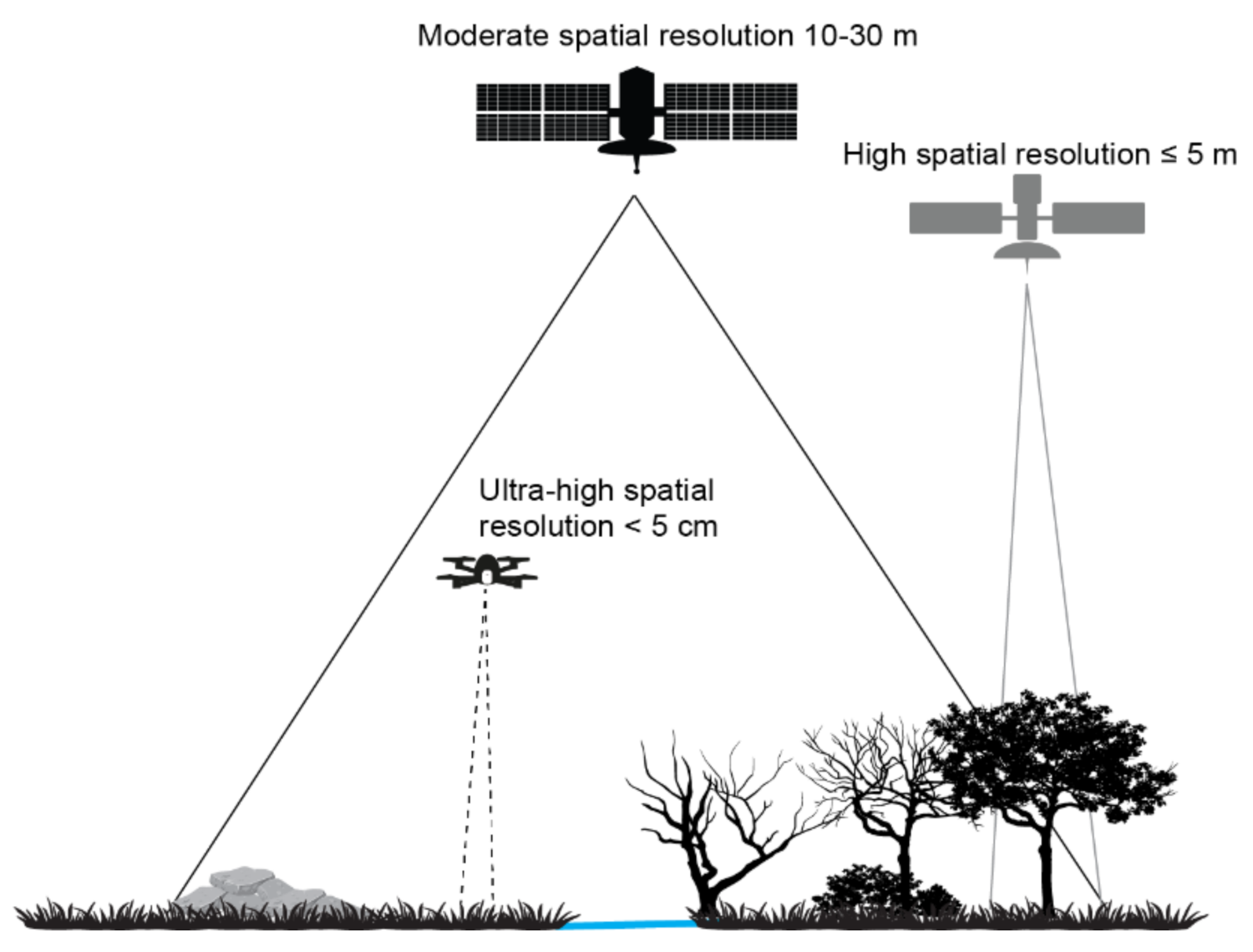
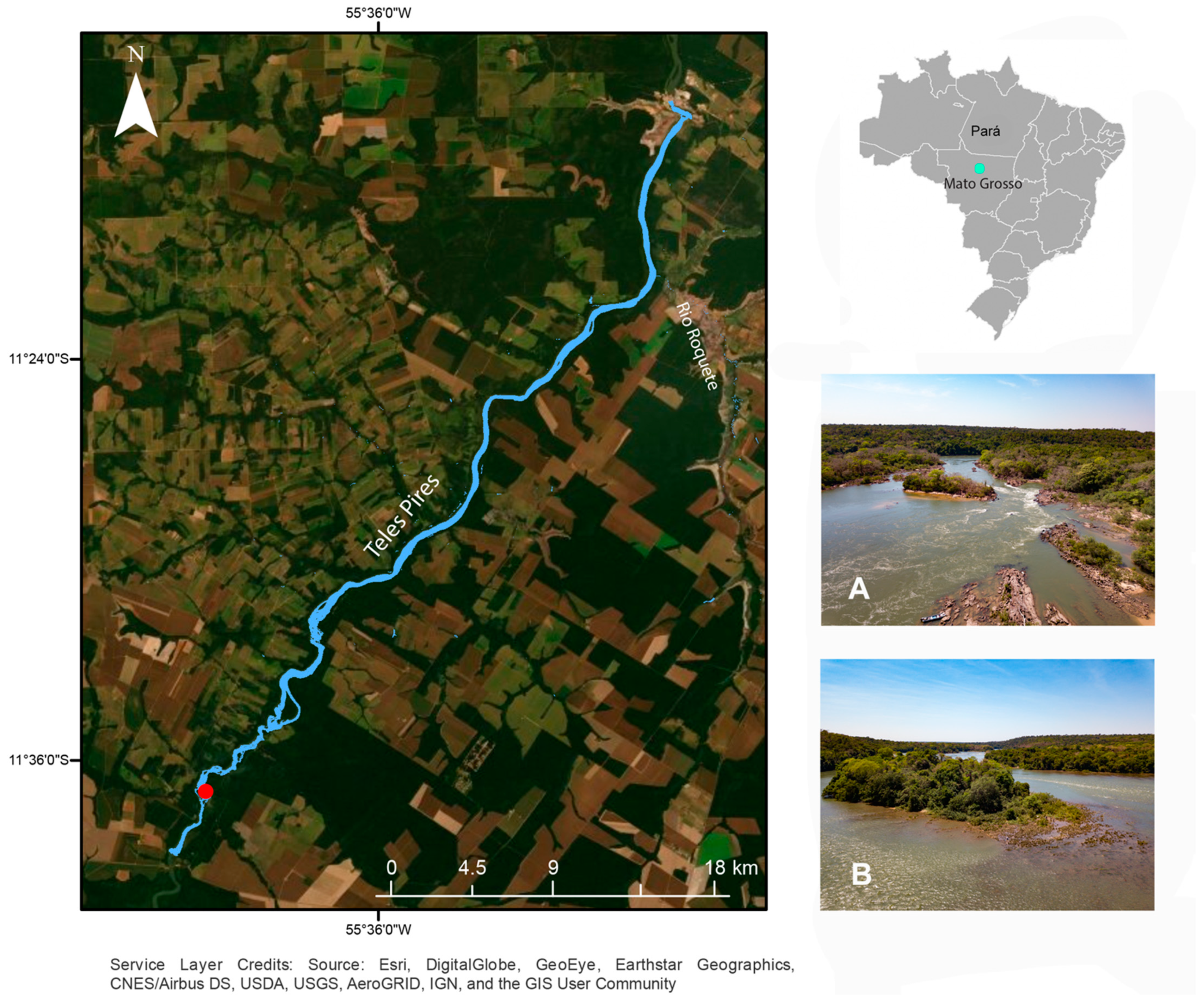
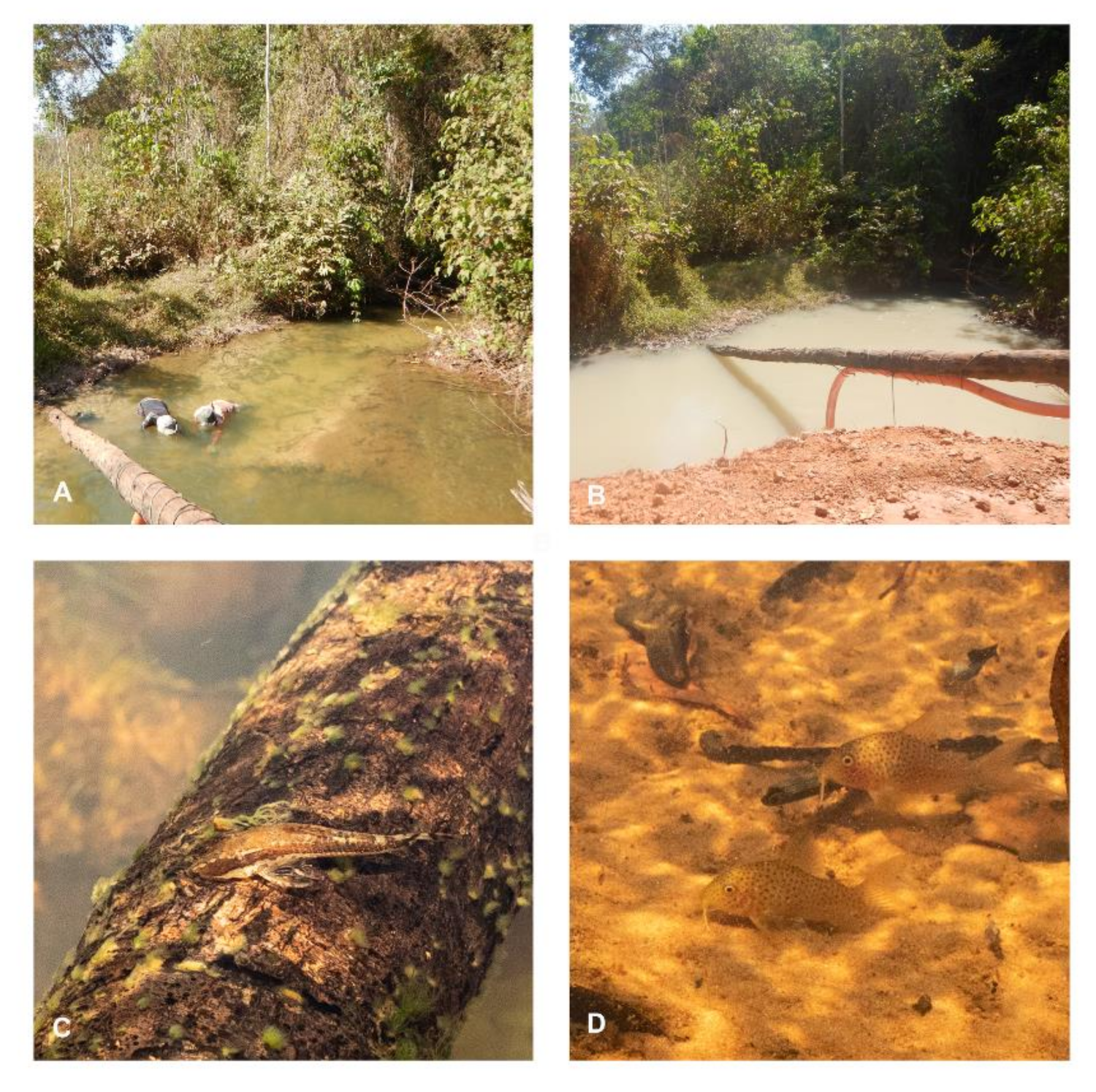
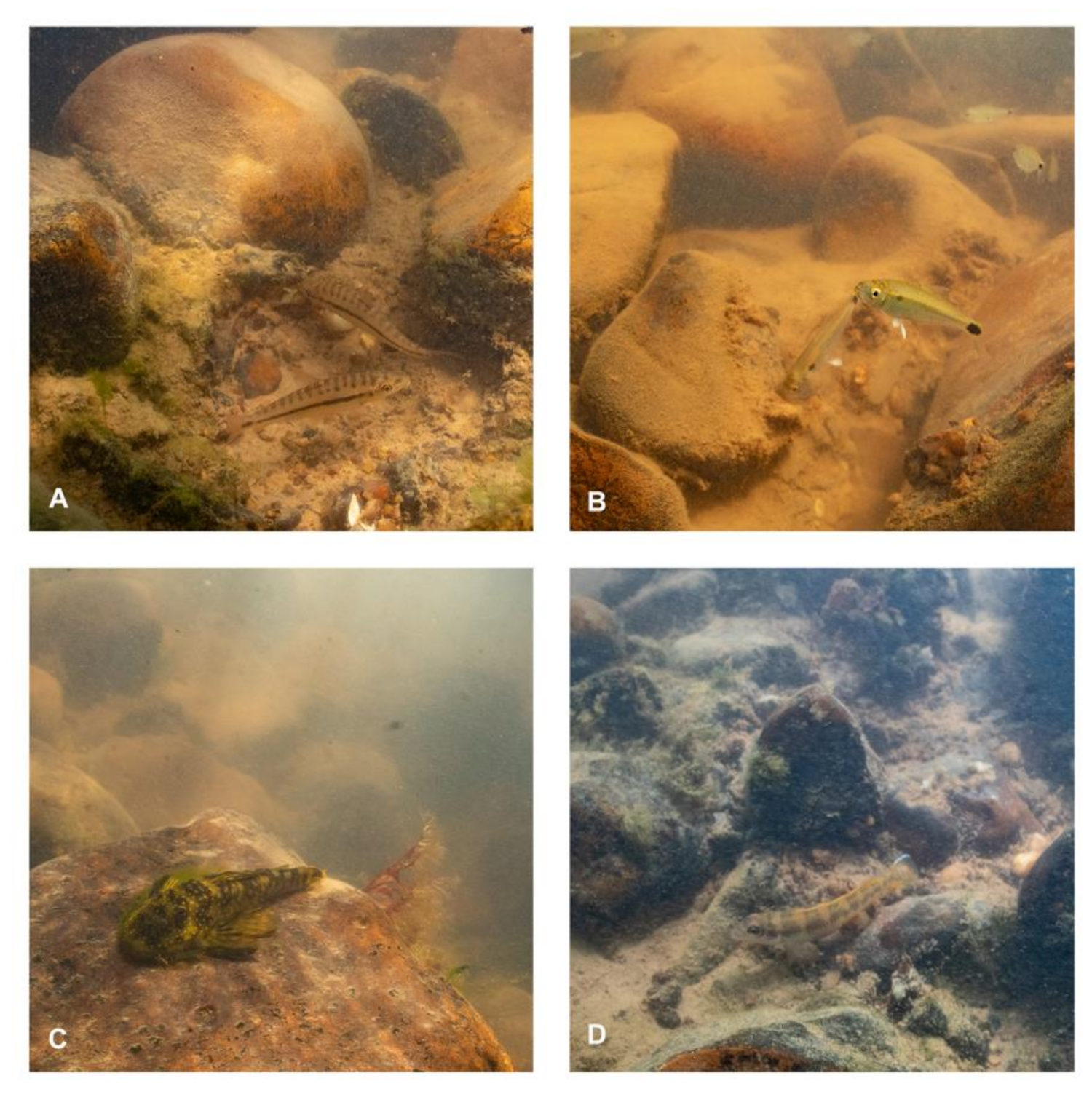
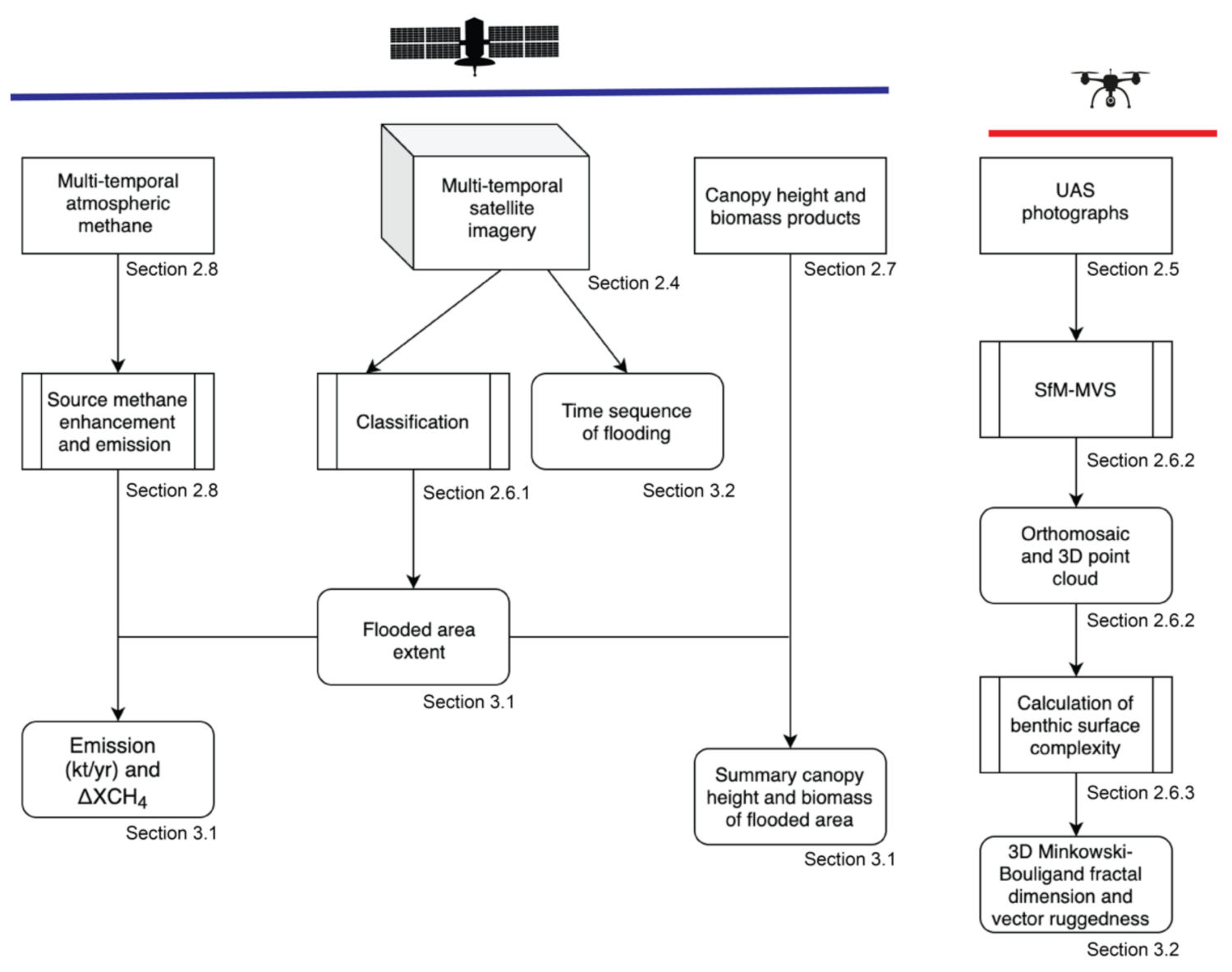
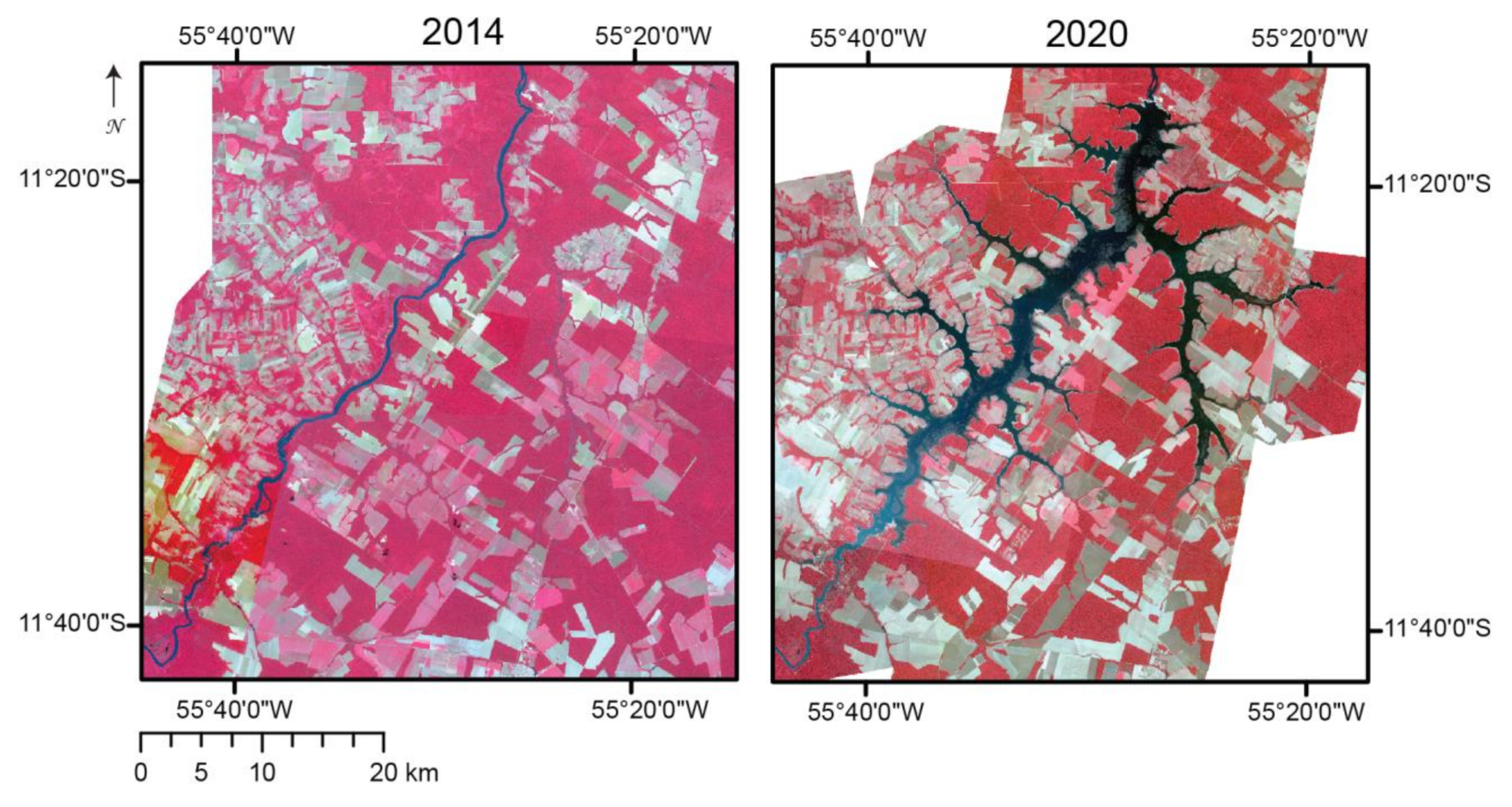
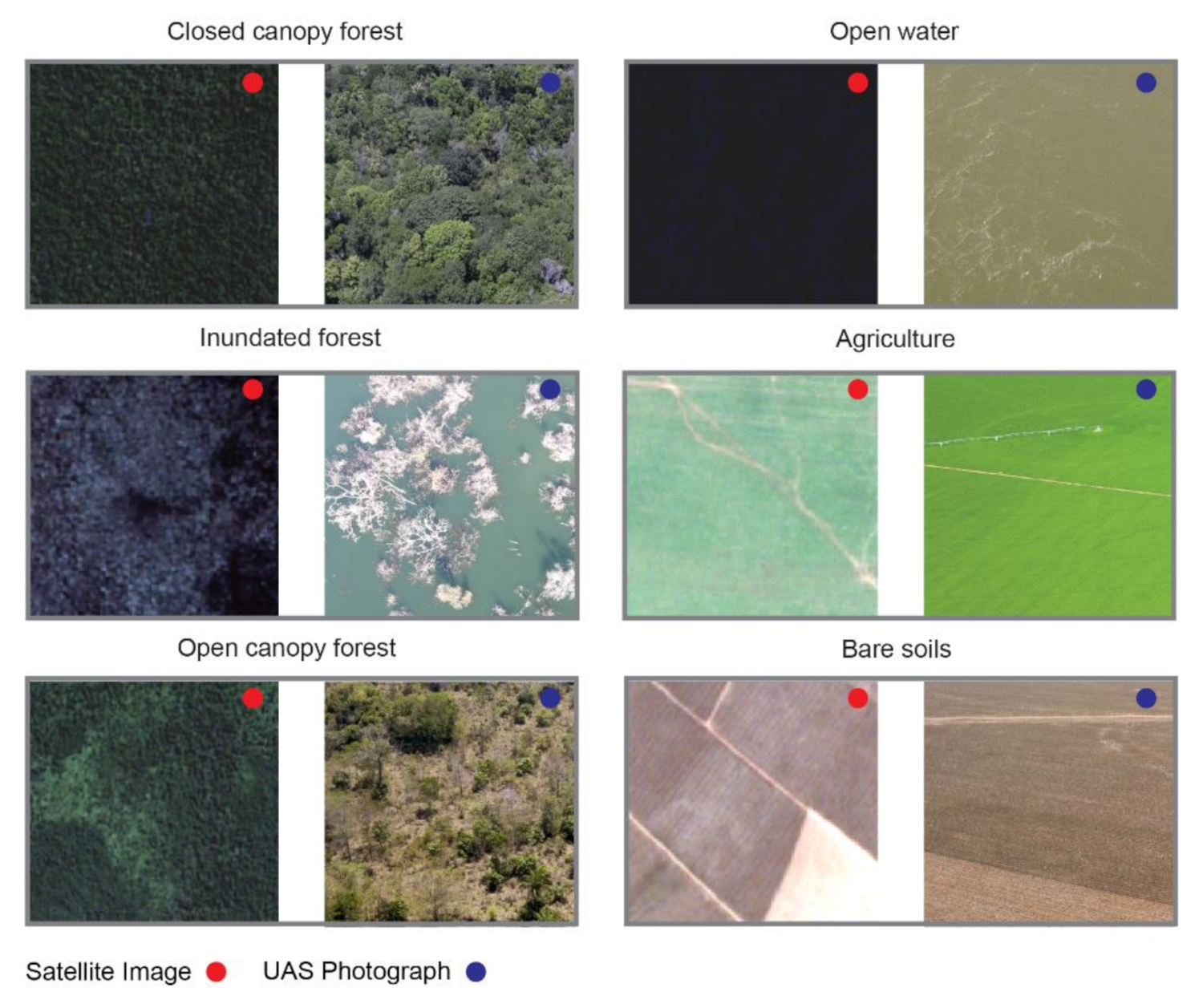
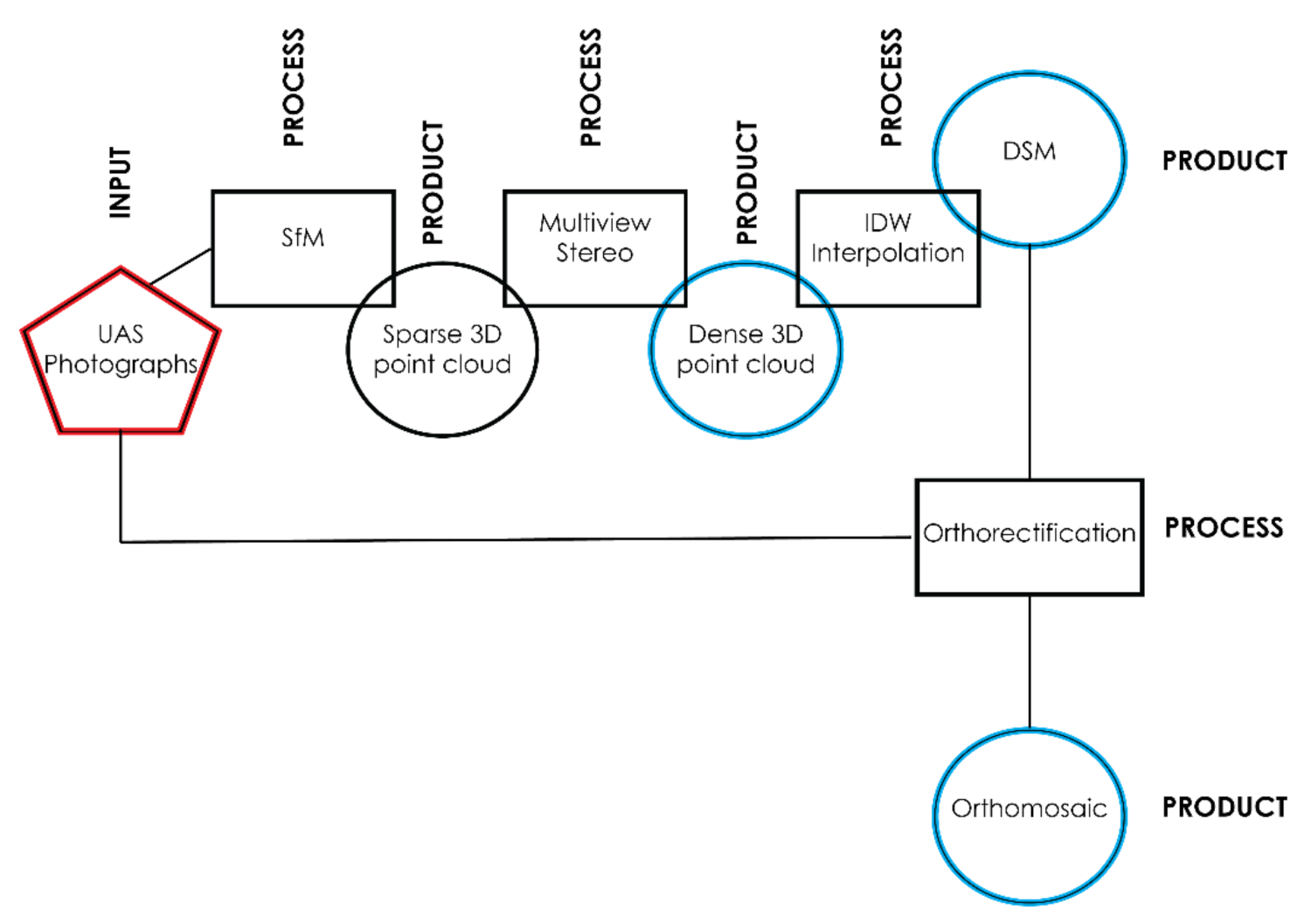
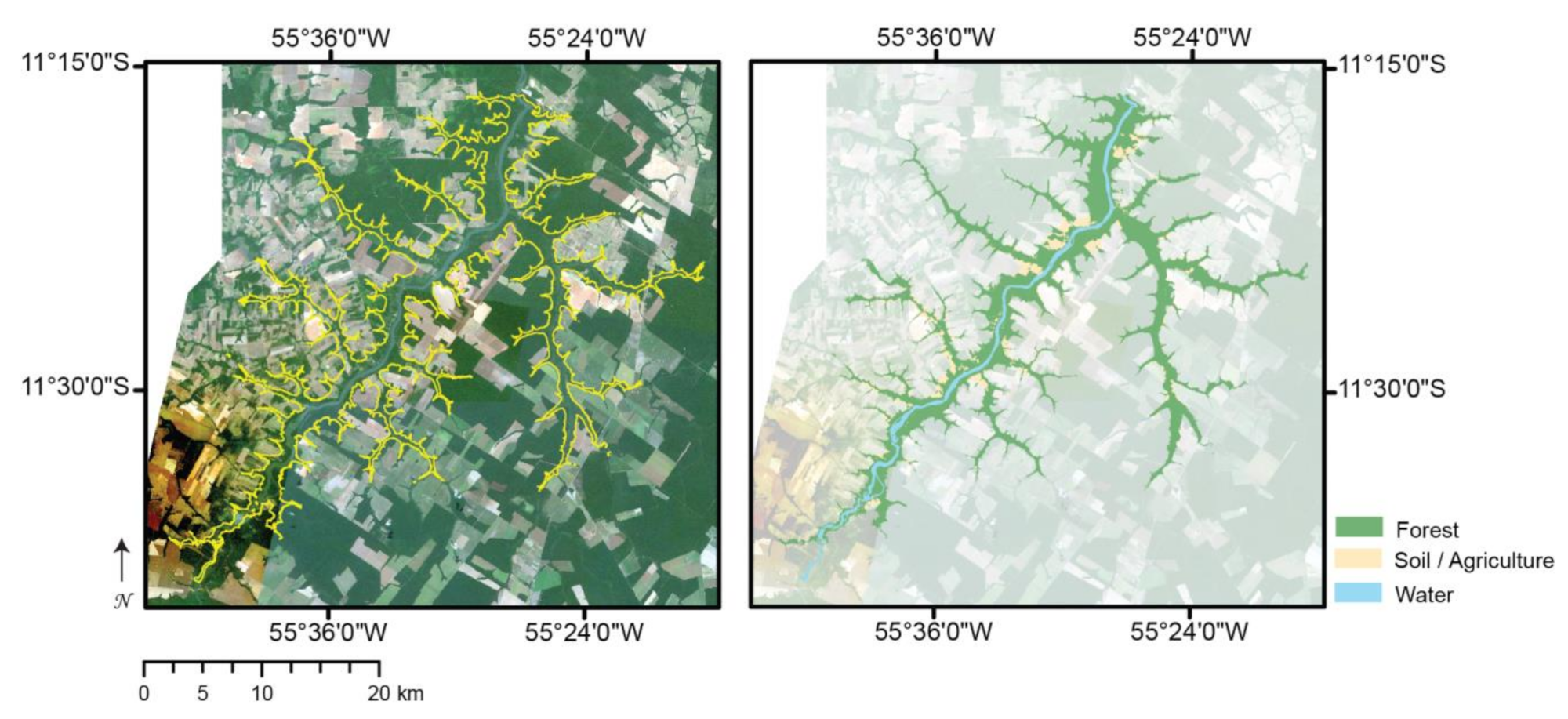
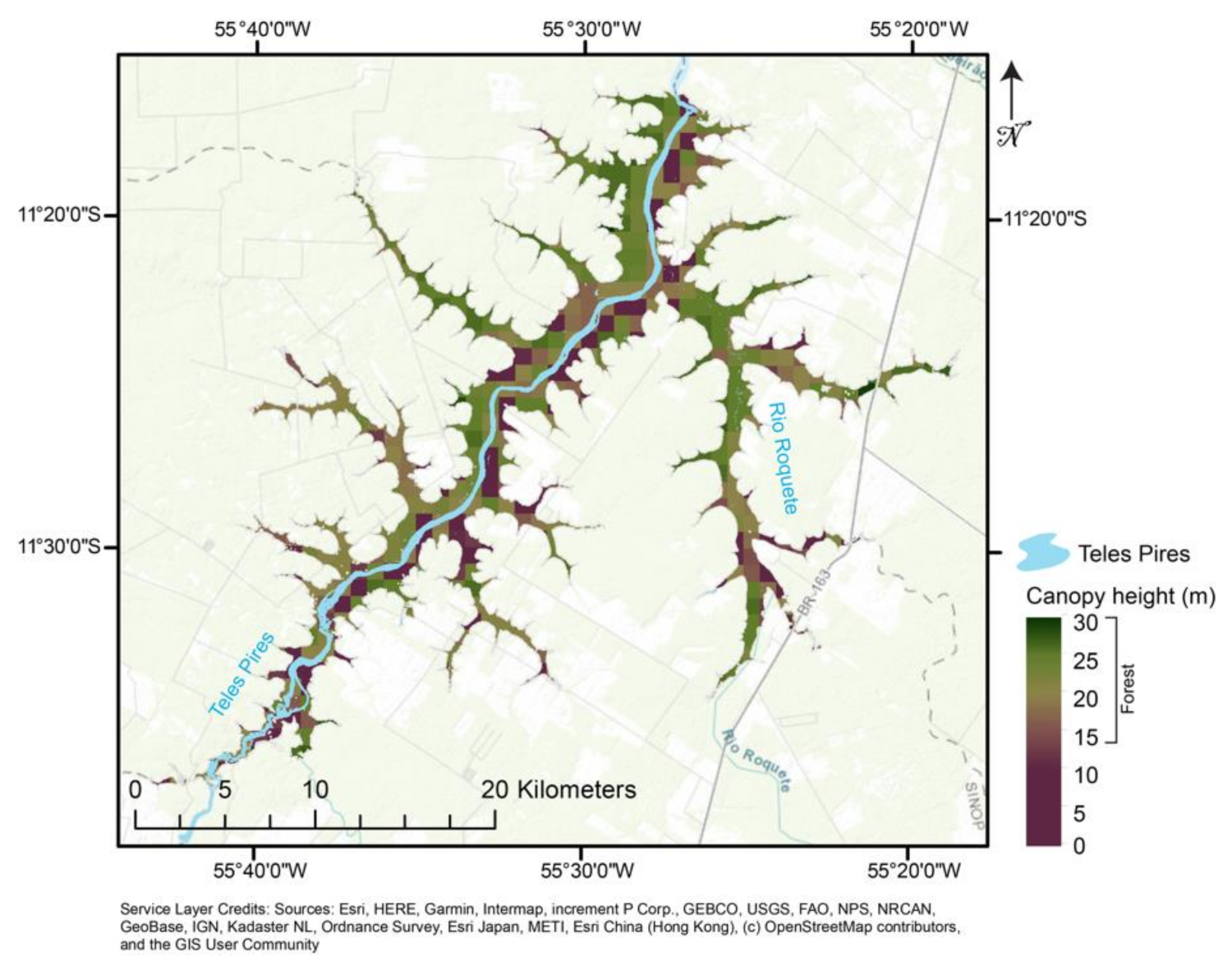
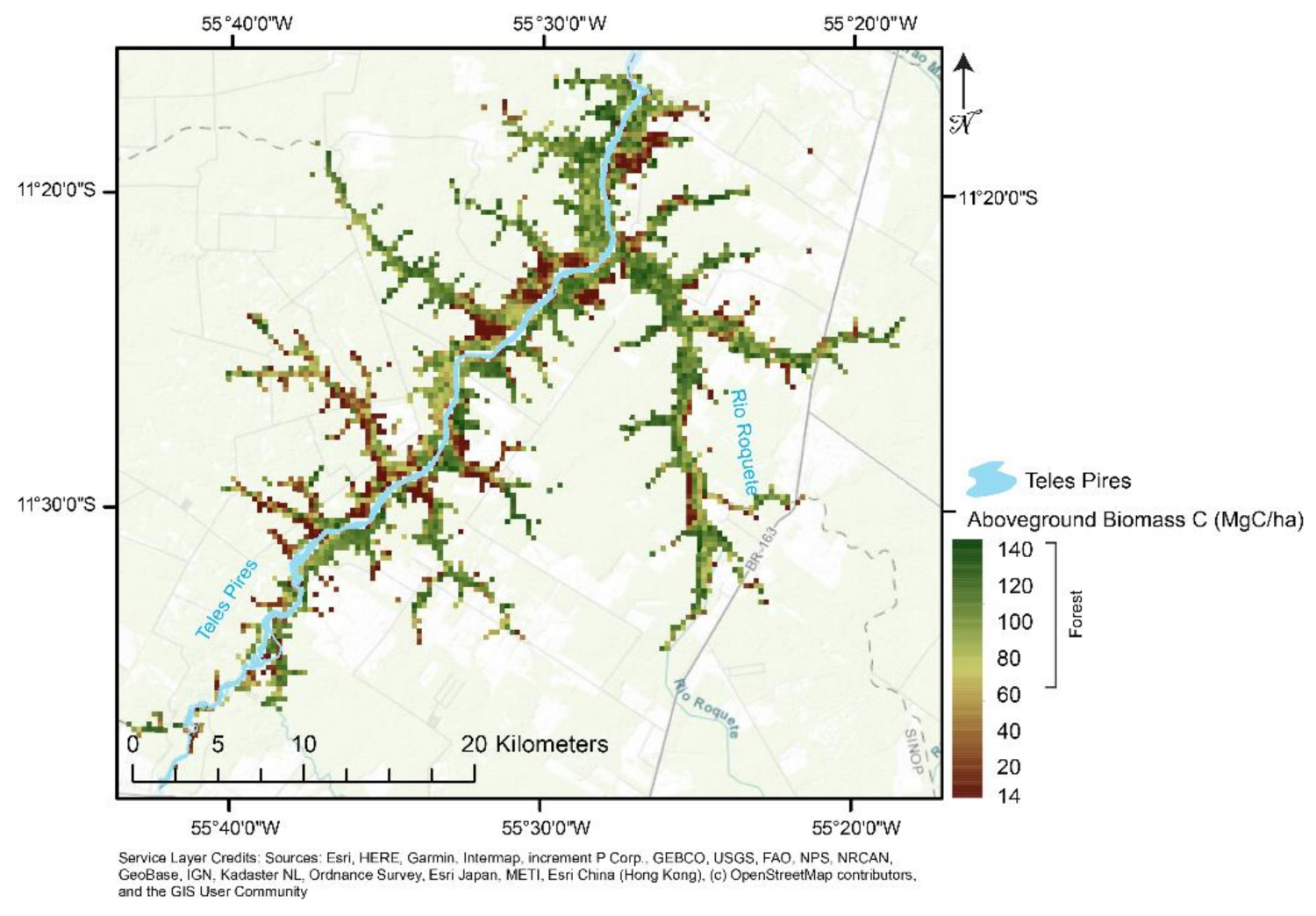
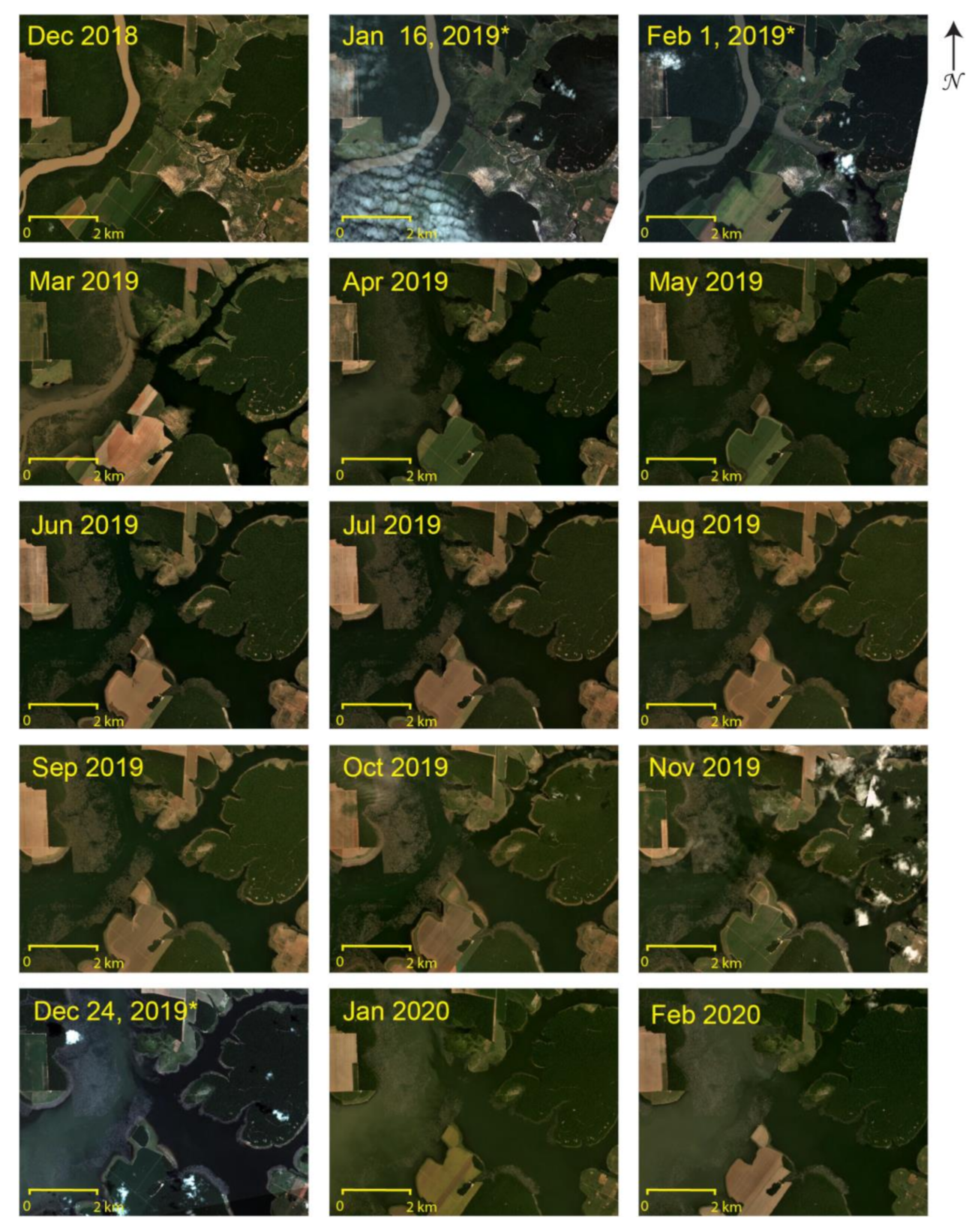
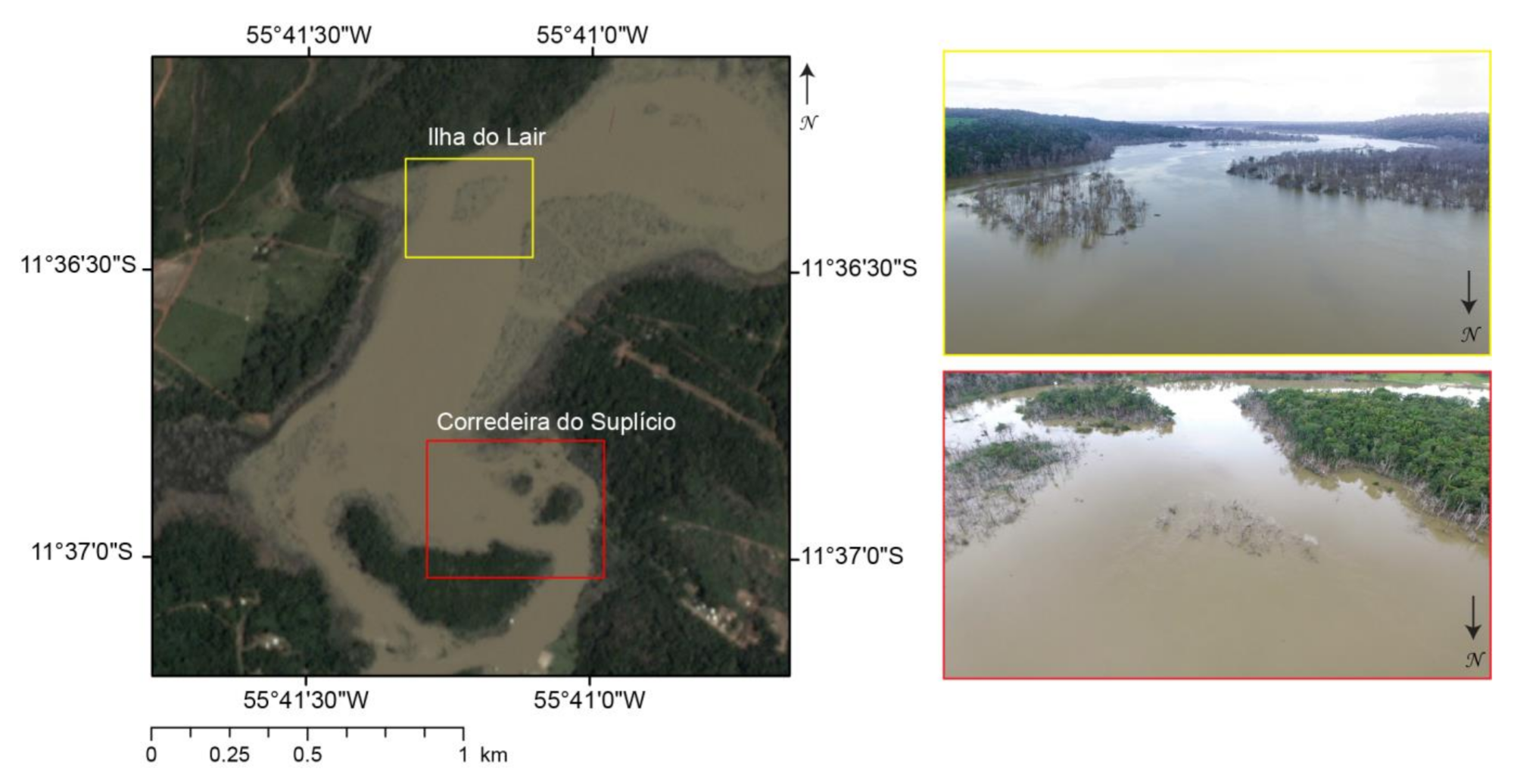
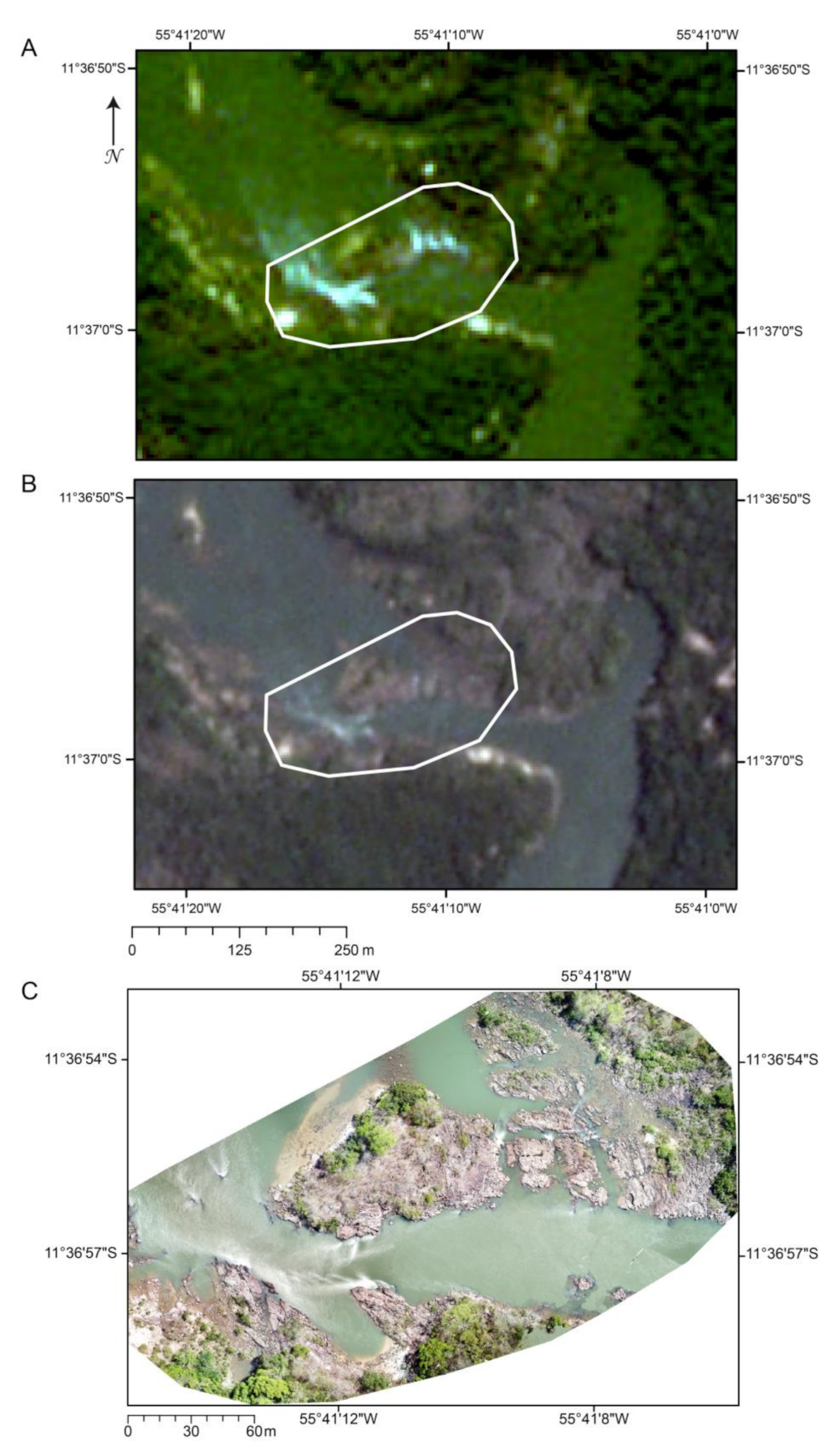
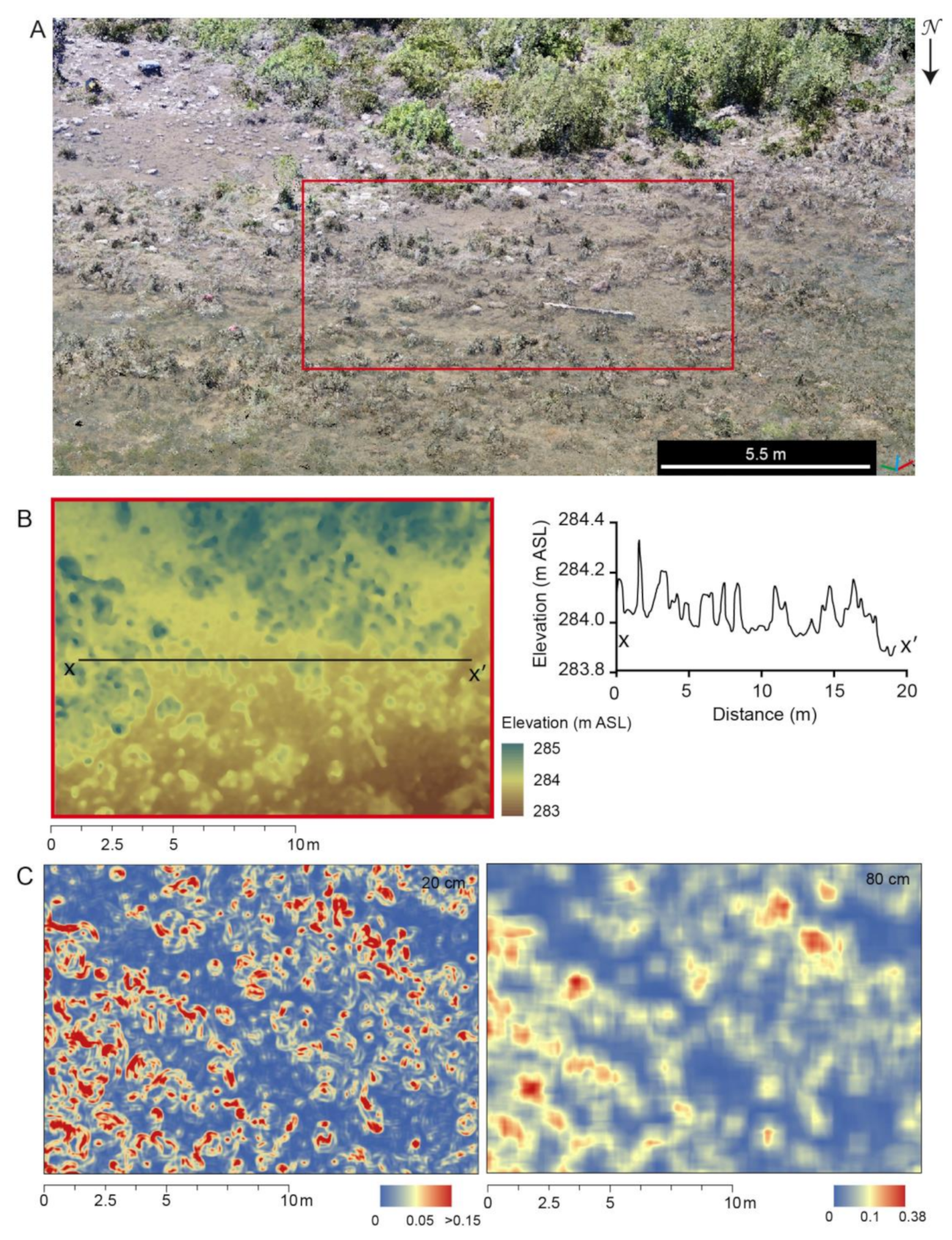
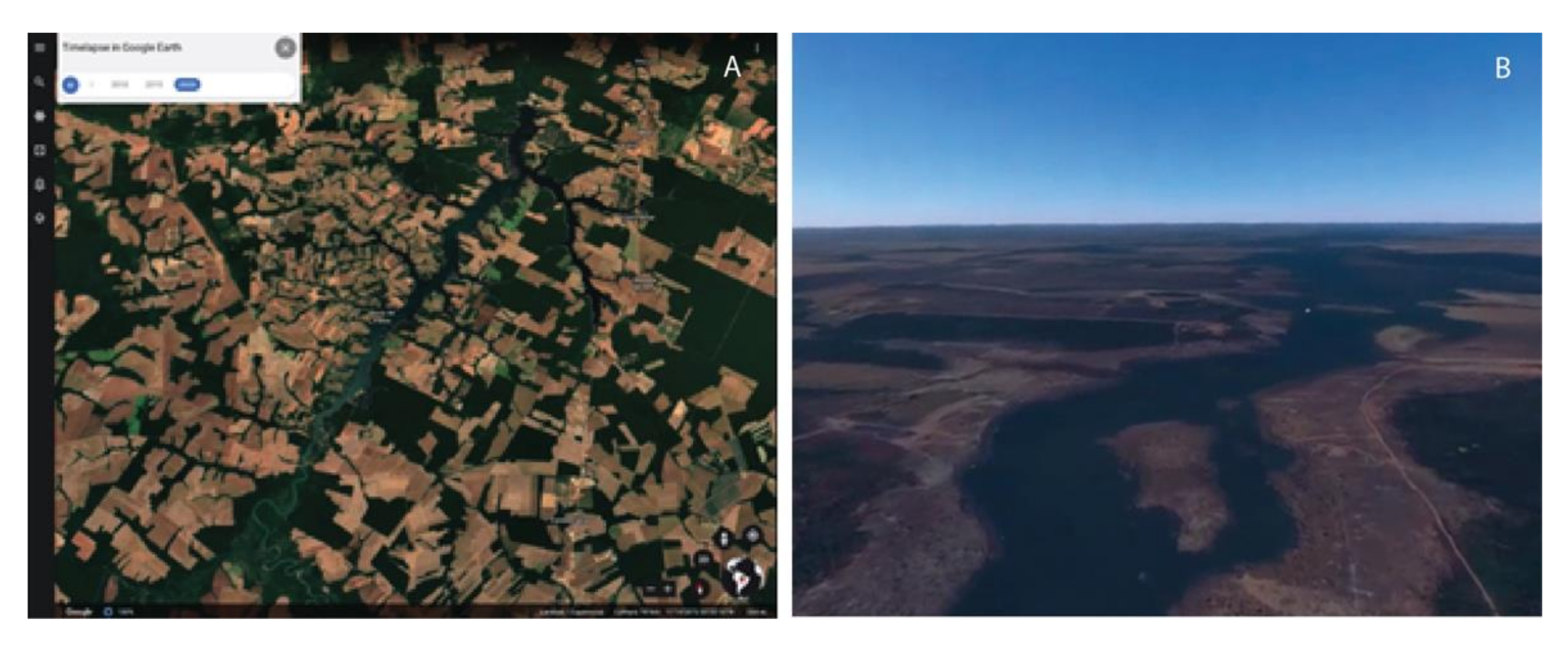
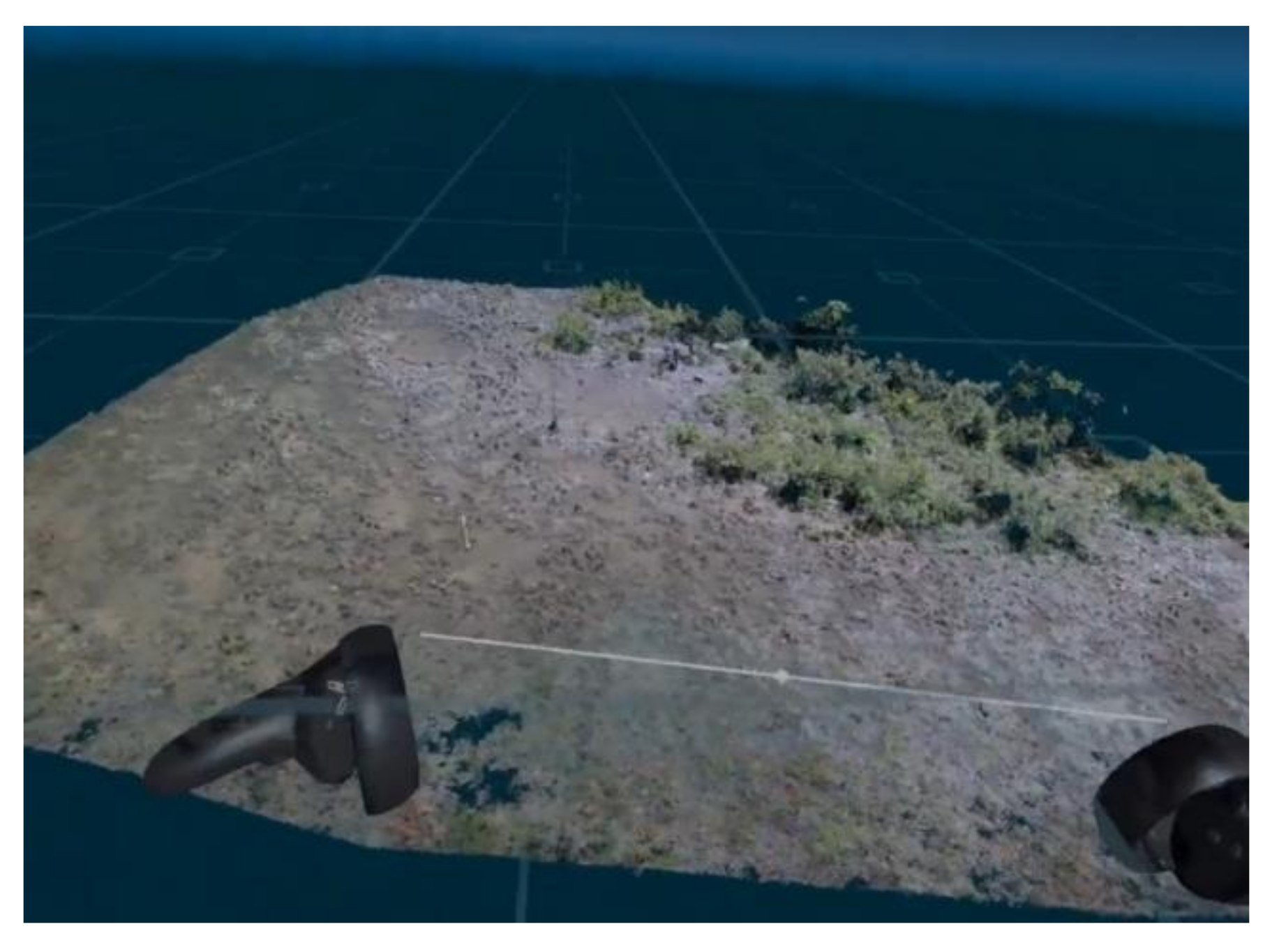
| Season | Dates | Constellation | No. Scenes |
|---|---|---|---|
| Low water, Pre-dam | May 31 and July 11, 2014 | RapidEye | 13 |
| High water, Pre-dam | February 9, 2018 | Dove PS | 8 |
| Low water, Post-dam | July 5, 7 and 8, 2020 | Dove PS | 24 |
| High water, Post-dam | January 11, 15, 31, February 13, 14, 17, 2020 | Dove PS | 25 |
| Land Cover | Area (km2) Low Water | Area (km2) High Water |
|---|---|---|
| Water | 19.79 | 19.91 |
| Soil/Agriculture | 25.62 | 38.10 |
| Forest | 163.04 | 177.07 |
| Total | 208.45 | 235.08 |
| Forest Reference | Water Reference | Soil/Agriculture Reference | User’s Accuracy (%) | |
|---|---|---|---|---|
| Forest classification | 211 | 0 | 9 | 95.9 |
| Water classification | 1 | 54 | 0 | 98.2 |
| Soil/Agriculture classification | 6 | 0 | 88 | 93.6 |
| Producer’s Accuracy (%) | 96.8 | 100 | 90.7 | OA = 95.7% |
| Site | Month | XCH4 (ppb) (µ ± σ) |
|---|---|---|
| HPPS lentic zone | July | 1852.5 ± 6.8 |
| HPPS lentic zone | August | 1856.3 ± 9.4 |
| Background region | July | 1849.8 ± 14.2 |
| Background region | August | 1851.9 ± 15.9 |
| Xingu National Park | July | 1807.5 ± 10.0 |
| Xingu National Park | August | 1809.9 ± 10.8 |
Publisher’s Note: MDPI stays neutral with regard to jurisdictional claims in published maps and institutional affiliations. |
© 2021 by the authors. Licensee MDPI, Basel, Switzerland. This article is an open access article distributed under the terms and conditions of the Creative Commons Attribution (CC BY) license (https://creativecommons.org/licenses/by/4.0/).
Share and Cite
Lucanus, O.; Kalacska, M.; Arroyo-Mora, J.P.; Sousa, L.; Carvalho, L.N. Before and After: A Multiscale Remote Sensing Assessment of the Sinop Dam, Mato Grosso, Brazil. Earth 2021, 2, 303-330. https://doi.org/10.3390/earth2020018
Lucanus O, Kalacska M, Arroyo-Mora JP, Sousa L, Carvalho LN. Before and After: A Multiscale Remote Sensing Assessment of the Sinop Dam, Mato Grosso, Brazil. Earth. 2021; 2(2):303-330. https://doi.org/10.3390/earth2020018
Chicago/Turabian StyleLucanus, Oliver, Margaret Kalacska, J. Pablo Arroyo-Mora, Leandro Sousa, and Lucélia Nobre Carvalho. 2021. "Before and After: A Multiscale Remote Sensing Assessment of the Sinop Dam, Mato Grosso, Brazil" Earth 2, no. 2: 303-330. https://doi.org/10.3390/earth2020018
APA StyleLucanus, O., Kalacska, M., Arroyo-Mora, J. P., Sousa, L., & Carvalho, L. N. (2021). Before and After: A Multiscale Remote Sensing Assessment of the Sinop Dam, Mato Grosso, Brazil. Earth, 2(2), 303-330. https://doi.org/10.3390/earth2020018







